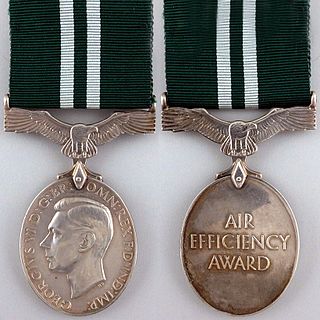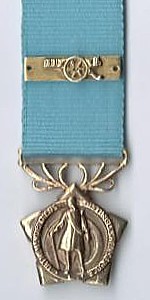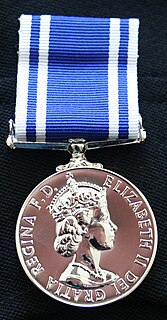
The Republic of Sierra Leone Armed Forces (RSLAF) is the armed forces of Sierra Leone, responsible for the territorial security of Sierra Leone's border and defending the national interests of Sierra Leone, within the framework of its international obligations. The armed forces were formed after independence in 1961, on the basis of elements of the former British Royal West African Frontier Force, then present in the country. The Sierra Leone Armed Forces currently consist of around 13,000 personnel.

Prince Edward, Duke of Kent, is a member of the British royal family. He is a first cousin of Queen Elizabeth II through their fathers, Prince George, Duke of Kent, and King George VI. Edward is also a first cousin once removed of Prince Philip, Duke of Edinburgh via his mother, Princess Marina of Greece and Denmark.

The Honoris Crux of 1952, post-nominal letters HC, is a military decoration for bravery which was instituted by the Union of South Africa in 1952. It was in use from 1952 to 1975 and was awarded to members of the South African Defence Force for gallantry in action against the enemy in the field. It was discontinued on 1 July 1975, when it was replaced by a new set of four Honoris Crux decorations, in four classes.

The Air Efficiency Award, post-nominal letters AE for officers, was instituted in 1942. It could be awarded after ten years of meritorious service to officers, airmen and airwomen in the Auxiliary and Volunteer Air Forces of the United Kingdom and the Territorial Air Forces and Air Force Reserves of the Dominions, the Indian Empire, Burma, the Colonies and Protectorates.

The Van Riebeeck Decoration, post-nominal letters DVR, is a South African military decoration for bravery which was instituted by the Union of South Africa in 1952. It was awarded to officers for distinguished service in the field.

The Efficiency Decoration, post-nominal letters TD for recipients serving in the Territorial Army of the United Kingdom or ED for those serving in the Auxiliary Military Forces, was instituted in 1930 for award to part-time officers after twenty years of service as an efficient and thoroughly capable officer. The decoration superseded the Volunteer Officers' Decoration, the Colonial Auxiliary Forces Officers' Decoration and the Territorial Decoration.

The Police Long Service and Good Conduct Medal is a decoration for police officers of the United Kingdom. First instituted in 1951, the medal is presented for twenty aggregate years of service in the police services of the United Kingdom.
The Nigerian Independence Medal was authorised by Queen Elizabeth II on the occasion of the granting of independence to Nigeria to give recognition to individuals of the Royal Nigerian Military Forces, Royal Nigerian Navy and the Nigeria Police Force serving on 1 October 1960 and to members of the United Kingdom Land Forces who were seconded to the Royal Nigerian Military Forces.

The Indian Independence Medal was instituted by the Dominion of India and approved by King George VI by way of a Royal Warrant dated 21 July 1948. It was a commemorative medal for service with the Indian armed forces at the time of independence in August 1947. Attached British personnel were eligible.

Sierra Leone was a sovereign state with Queen Elizabeth II as its head of state between independence on 27 April 1961 and becoming the Republic of Sierra Leone on 19 April 1971.

From 1961 to 1971, Sierra Leone was an independent constitutional monarchy with Elizabeth II as Queen of Sierra Leone and its nominal head of state. The Queen was also the monarch of other Commonwealth realms, including the United Kingdom.
The Royal West African Frontier Force Long Service and Good Conduct Medal was established in September 1903 to reward native African NCOs and men who had completed 18 years, later reduced to 16 years, exemplary service in the Royal West African Frontier Force (RWAFF).

The first South African military medal was a campaign medal, the South Africa Medal, instituted in 1854 by Queen Victoria, the Monarch of the United Kingdom of Great Britain and Ireland, for award to officers and men of the Royal Navy and British Army who served on the Eastern Frontier of the Cape Colony between 1834 and 1853 during the Xhosa Wars.

The Union Medal was instituted by the Union of South Africa in 1952. It was awarded to Permanent Force members of the South African Defence Force for eighteen years of service and good conduct.

The Independence Medal was instituted by the State President of the Republic of Transkei to commemorate Independence on 26 October 1976. It was awarded to all ranks on the active strength of the Transkei Defence Force upon independence.

The Queen's Medal for Champion Shots of the New Zealand Naval Forces was retrospectively instituted for New Zealand in 1958, the first medal having already been awarded in 1955. The medal is a Naval counterpart of the Queen's Medal for Champion Shots in the Military Forces and the Queen's Medal for Champion Shots of the Air Forces. One medal can be awarded annually to the champion shot of a small-arms marksmanship competition held by the Royal New Zealand Navy.

The Medal for the Best Shot in the British Army, Infantry, was instituted by Queen Victoria in 1869 and was awarded annually from 1870 to 1882 to the best shot of the Infantry of the British Army, including the Royal Engineers and the Colonial Corps.

A number of new Sierra Leone medals were instituted in the decade from 1961, when the country gained independence.
















